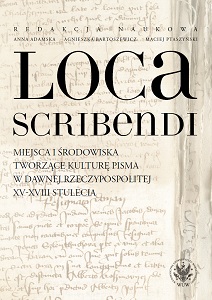Miejsca działalności konsystorza generalnego w Poznaniu i jego pisarzy w pierwszej ćwierci XV w.
The places of work of the general consistory court in Poznań and its scribes in the first quarter of the 15th century
Author(s): Adam Kozak
Subject(s): Middle Ages, 6th to 12th Centuries, 13th to 14th Centuries, 15th Century, 16th Century, 17th Century, 18th Century
Published by: Wydawnictwa Uniwersytetu Warszawskiego
Keywords: writing environment; consistory; notary; writer; writing; office; books; XV-XVIII centuries; writing culture
Summary/Abstract: An important aspect of the organisation of the general consistory court in Poznań in the first quarter of the 15th century is that of the places where the court sessions were held, where the legal actions were performed (e.g. so-called ‘obligations’ and appointing of legal plenipotentiaries), and where the records of the proceedings were made. To establish these places the eight oldest registers of the consistory court (dating from 1404–1425) have been analysed, as well as almost 80 charters issued by the vicarii in spiritualibus and the officials of the bishopric of Poznań. Altogether, these records offer us more than 2,500 notices about the topography of legal actions. It can be shown that the activities mentioned before found place not only in houses on the centrally located island of Ostrów Tumski (belonging to the bishopric of Poznań), where the officials and vicarii in spiritualibus resided. Legal and notarial actions were also performed in the lodgings of notaries, in the curiae of canons, at the episcopal court, in the cathedral, and in St. Mary’s ‘in Summo’ church. Many other places both on Ostrów Tumski (the cathedral school and the houses of eternal vicars) and in other parts of the city can be added to this list. In 1425 the consistory court left Poznań and settled for some time in Dolsk (more than 50 kilometres south of Poznań). Generally, however, the places of the activities of the consistory court became ever more stable over time: the number of cases treated at the curia of the official and the vicar in spiritualibus grew from 77% of all cases presented to the bishop in 1404 to more than 99% in 1424. This change is clearly connected to the more than fourfold growth in litigious cases (the number of so-called obligations was grew twice as fast in this period). Another factor was the reform of the episcopal chancery’s organisation by bishop Andrzej Łaskarz (1414–1426), who was a remarkable intellectual. The loca agendi and loca scribendi of the Poznań consistory court were usually identical. A separate space for the notaries was created in the curia of the officials (and probably also at the office of the vicarii in spiritualibus). This provided the judges with the permanent assistance of chancery clerks.
- Page Range: 126-151
- Page Count: 26
- Publication Year: 2017
- Language: Polish
- Content File-PDF

